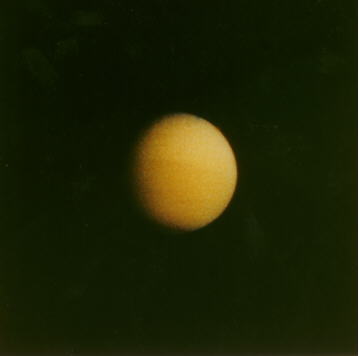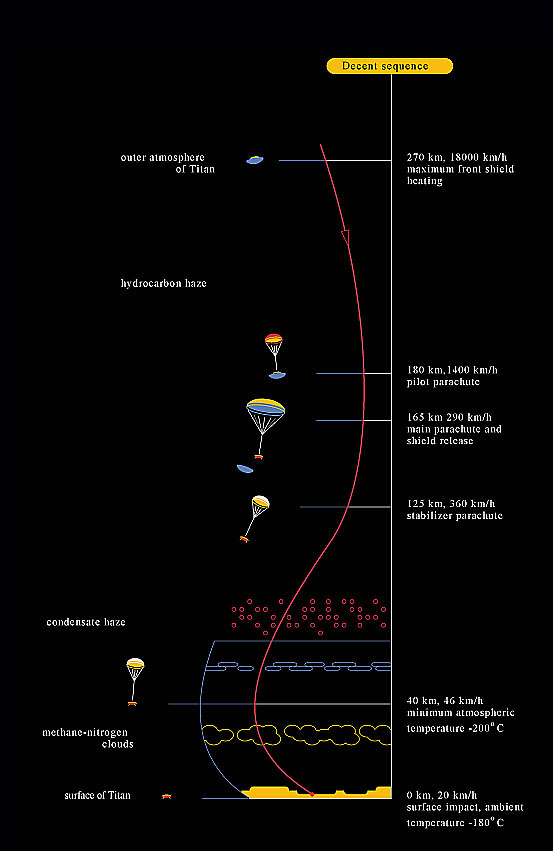SCIENTIFIC OBJECTIVES
Rationale

The origin of Titan's hazes is most currently attributed to photochemical processes occuring at high altitudes. Ions and radicals produced from N2 and CH4 by UV photolysis and energetic particles bombardment recombine chemically, forming organics, some of which polymerize to create the aerosol.
Owing to the diversity of the possible energy sources and their related vertical distribution, different types of particles are expected to occur with respect to the altitude ranges. The polymerization of C2H2 through the action of solar UV photons is expected, from current modeling, to yield C2nH2 at altitudes larger than ~ 500km. The synthesis, in large amounts, of polymers of the form (C2H2)n in the lower stratosphere may be considered as rather unlikely but depends on how the acetylene polymerizes long-ward of 190 nm (Chassefičre & Cabane, 1995). The formation of C-H-N tholin oligomers by the action of suprathermal Saturn plasma electrons, around 900-1000 km, or of energetic radiation belt particles at 350-400 km altitude, is shown to be the most plausible mechanism for explaining the haze's formation.
In the low stratosphere, aerosol particles settling down from the upper levels may act as condensation nuclei. Below ~ 80 km, this should lead to the deposition of thin layers (< 0.01µm) of condensed gases (e.g. HC3N, HCN, C4H10) on the sub-µ particles. This first stage is followed by a more consistent increase in the particle size, up to a few µm, where the condensation of CO2, C3H8, C2H2 and C3H6 occurs, between 67 and 63 km (Frčre et al., 1990). The main condensation processes occur near the tropopause, with the condensation of C2H6 below 62 km, and in the troposphere where CH4 and N2 condense on the resulting particle, which may yield cloud droplets (~ 100 µm, see Toon et al., 1992). Another source of condensation nuclei may be the particles produced directly at these altitudes by the radiolysis of organic gases. Cosmic rays present a maximum of the energy deposition near 60 km and, as on Earth, lightning may exist!
in the low troposphere.
Two methods of producing Titan-like aerosols in the laboratory have been investigated :
- The first involves identifying these aerosols with the complex organic material that is often observed in the laboratory from simulating the photolytic and radiolytic processes expected in Titan's atmosphere. This material roughly corresponds to what Sagan's group labels "tholins".
- The second route for producing the yellowish aerosols that might correspond to those of Titan, is by polymerizing organic molecules using UV. The best candidate is C2H2, which polymerizes more easily than C2H4 or HCN (Clarke & Ferris, 1997).
These polymers are expected to form the aggregates that are needed to reconcile polarimetric and photometric results (West & Smith, 1991; Cabane et al., 1992, 1993; Rannou et al., 1993, 1995, 1997).
Tholins obtained from the sparking of He-CH4 and N2-CH4 mixtures have been studied, with the ACP experiment in mind, (Israël et al., 1991; see also Raulin et al., 1992; Coll et al., 1998, 1999). The pyrolysis gas chromatography (Py-GC) of tholins produced at 77K shows them to include saturated and unsaturated carbon chains in their structure ; N-containing groups appear in the case of N2-CH4 sparking. The thermal desorption profile of these tholins clearly showed two peaks, the first one corresponding to the distillation of condensed species, the second one to the pyrolysis. The mass spectrometer (MS) study of the evaporated oligomers and pyrolyzates showed that a wide range of alkylated aromatic compounds evolved from the sample, which indicates that such solids contain a 3-D polymer with a high degree of branching.
In other work (Ehrenfreund et al., 1995), the main peaks related to N-compounds observed in the GCMS are HCN, CH3CN, C2H5CN and longer chain nitriles. Only the saturated hydrocarbons are observed. The study of the evolution with temperature shows that HCN is a dissociation product during the whole Py-GC analysis process, which may imply that the nitriles can form thermostable structures in the tholins.
Expected results

Primary objectives, can be satisfied from measurements made during Probe entry by ACP coupled with GCMS :
- 1. Determine the chemical makeup of thc photochemical aerosol, i.e. infer the relative numbers of constituent molecules (C, H, N, O) composing the aerosol.
- 2. Obtain the relative abundances of condensed organics (e.g. C2H2, C2H6, HC3N, HCN) in a column average throughout the stratosphere. Compare with the abundance of constituent molecules in the aerosol nucleation sites.
- 3. Obtain the relative abundances of condensed organics (principally CH4, plus organics listed above) in a column averaged over the upper troposphere. Compare with the abundances of constituent molecules in the aerosol nucleation sites.
Secondary objectives of fundamental interest can also be satisfied with the aid of additional information acquired by other Probe instruments (mainly the Descent Imager/Spectral Radiometer) :
- 4. Obtain absolute abundance for all condensed species, averaged over the stratosphere and upper troposphere respectively.
- 5. Determine the mean sizes of aerosol nucleation sites averaged over the stratosphere, and compare with those in the upper troposphere.
- 6. Detection of non-condensable species, such as CO, eventually trapped in aerosols.


 Measurement Strategy & Operation Sequences
Measurement Strategy & Operation Sequences
 Back to ACP home page
Back to ACP home page